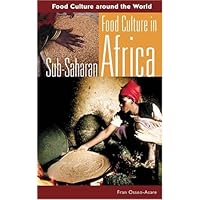
Average Reviews:

(More customer reviews)You won't find many recipes in this, nor will they be very exotic. But you will learn a lot about the driving forces behind the food. Even "Nando's Chickenland" has a section.
Sub-Saharan Africa is broken up in chunks and discussed seperately. Anything that the authors felt might influence food in some way is included, from Nando's to AIDs. This is a great book if you are interested in more than just the recipes, but if you are looking for recipes it might be best to avoid it.
Click Here to see more reviews about: Food Culture in Sub-Saharan Africa (Food Culture around the World)
East African, notably, Ethiopian, cuisine is perhaps the most well-known in the States. This volume illuminates West, southern, and Central African cuisine as well to give students and other readers a solid understanding of how the diverse African peoples grow, cook, and eat food and how they celebrate special occasions and ceremonies with special foods. Readers will also learn about African history, religions, and ways of life plus how African and American foodways are related. For example, cooking techniques such as deep frying and ingredients such as peanuts, chili peppers, okra, watermelon, and even cola were introduced to the United States by sub-Sahara Africans who were brought as slaves.
Africa is often presented as a monolith, but this volume treats each region in turn with representative groups and foodways presented in manageable fashion, with a truer picture able to emerge. It is noted that the boundaries of many countries are imposed, so that food culture is more fluid in a region. Commonalities are also presented in the basic format of a meal, with a starch with a sauce or stew and vegetables and perhaps some protein, typically cooked over a fire in a pot supported by three stones. Representative recipes, a timeline, glossary, and evocative photos complete the narrative.

0 comments:
Post a Comment